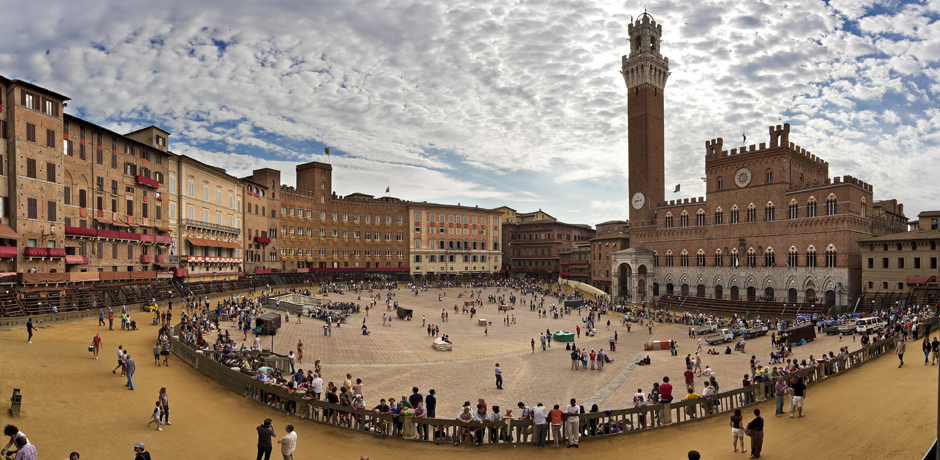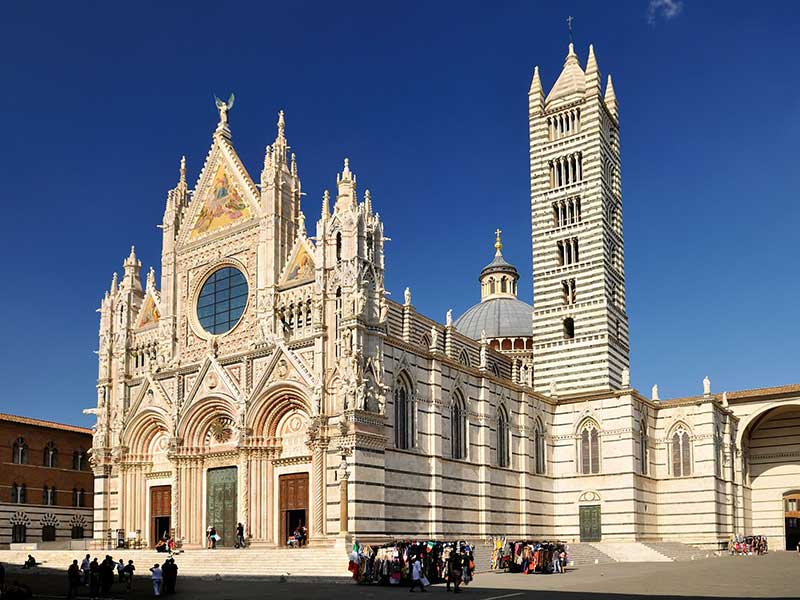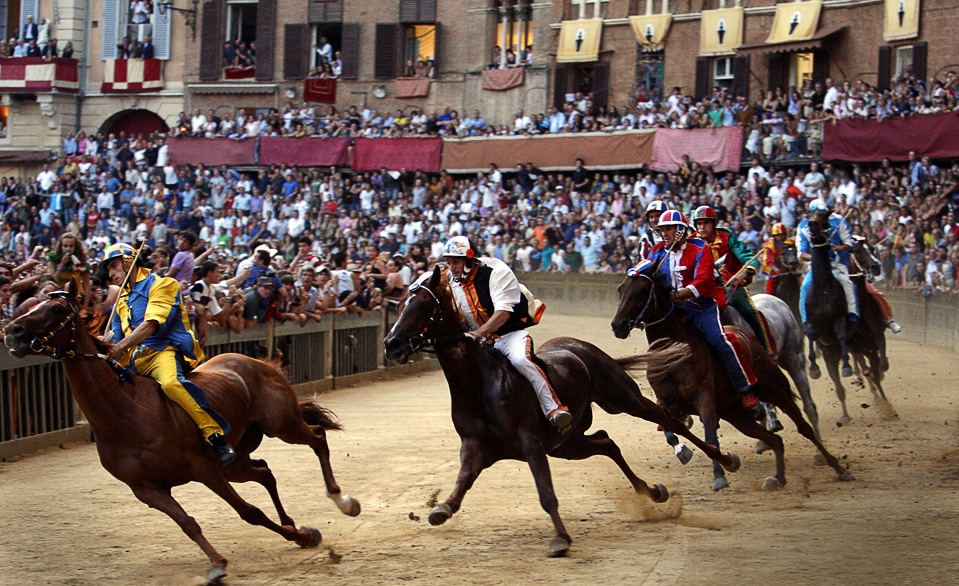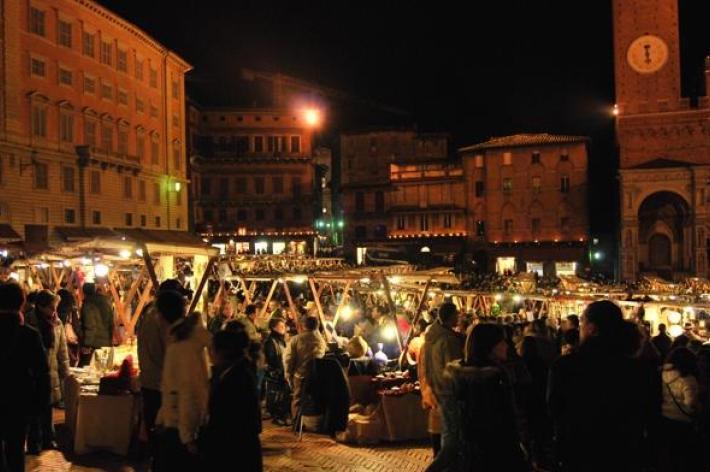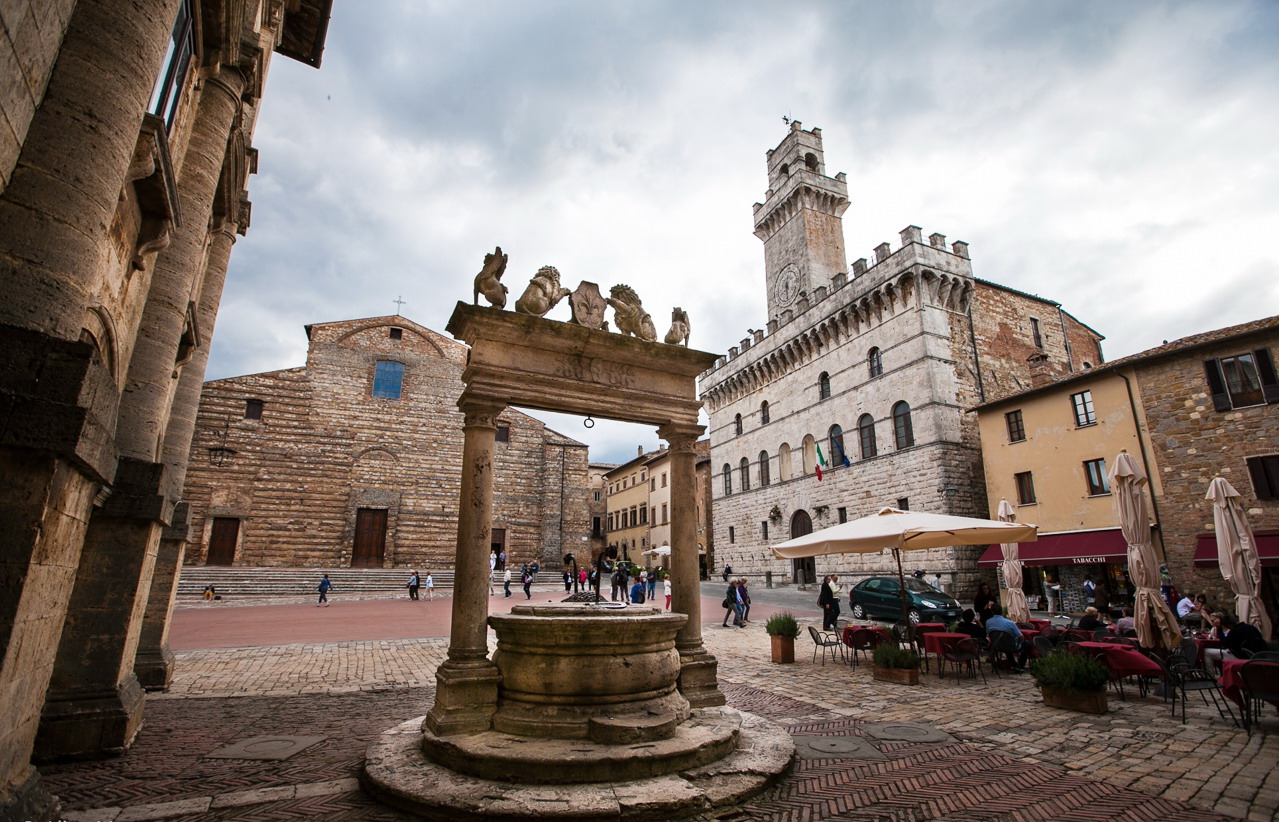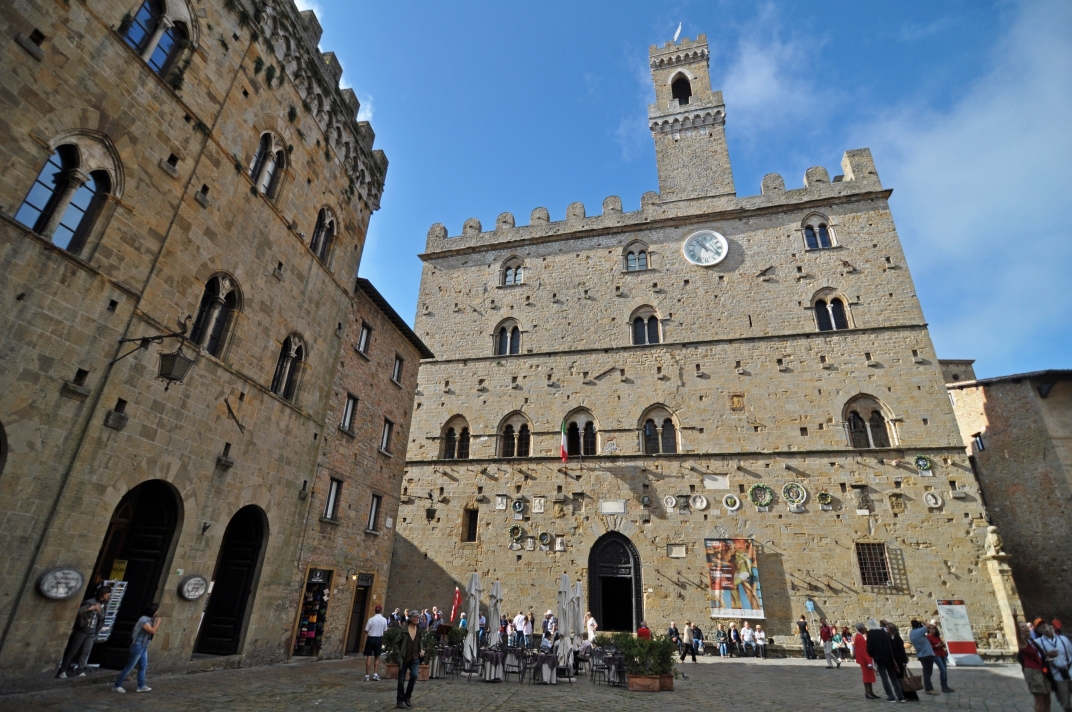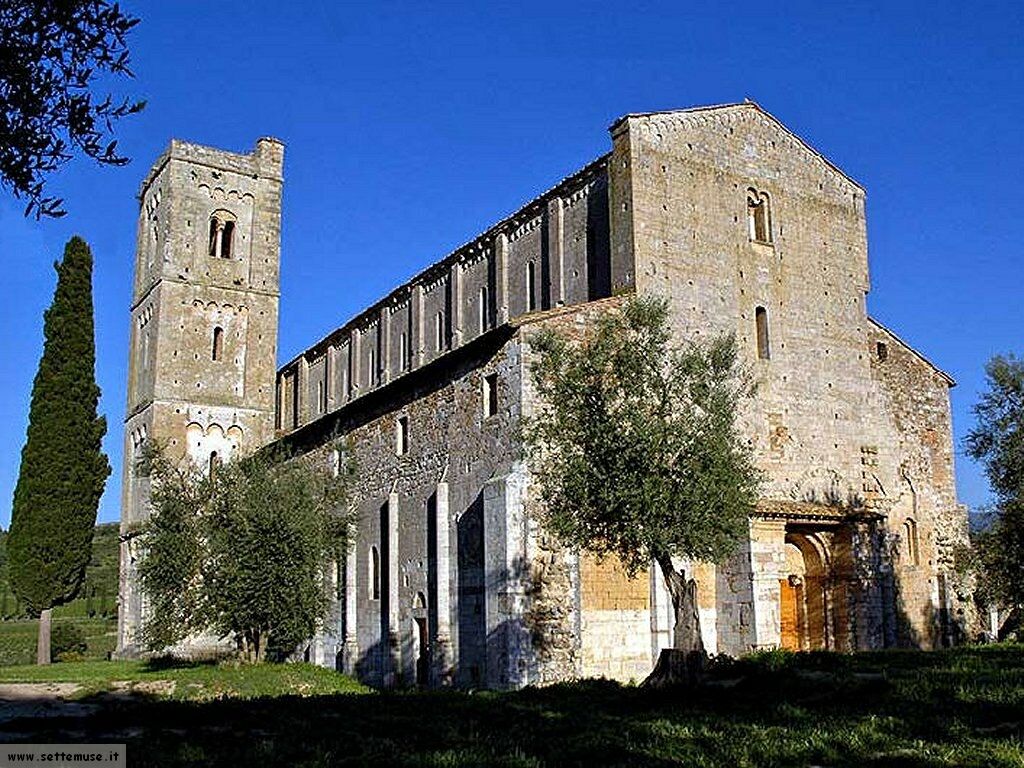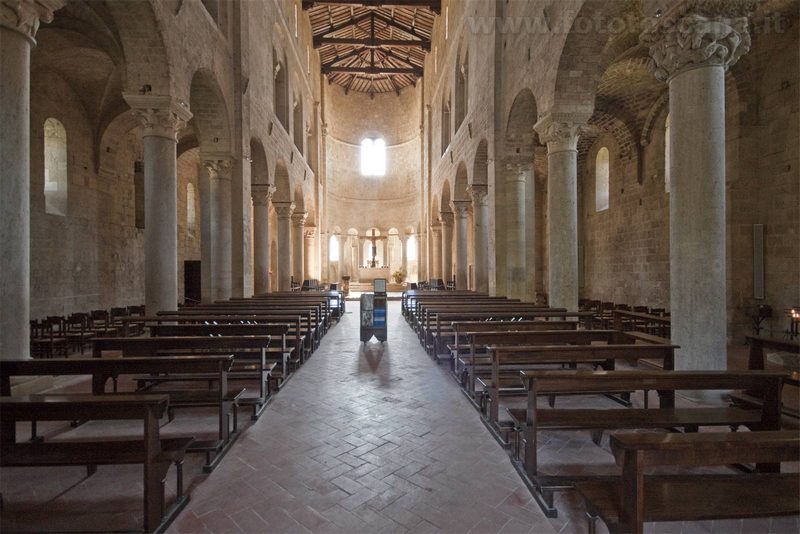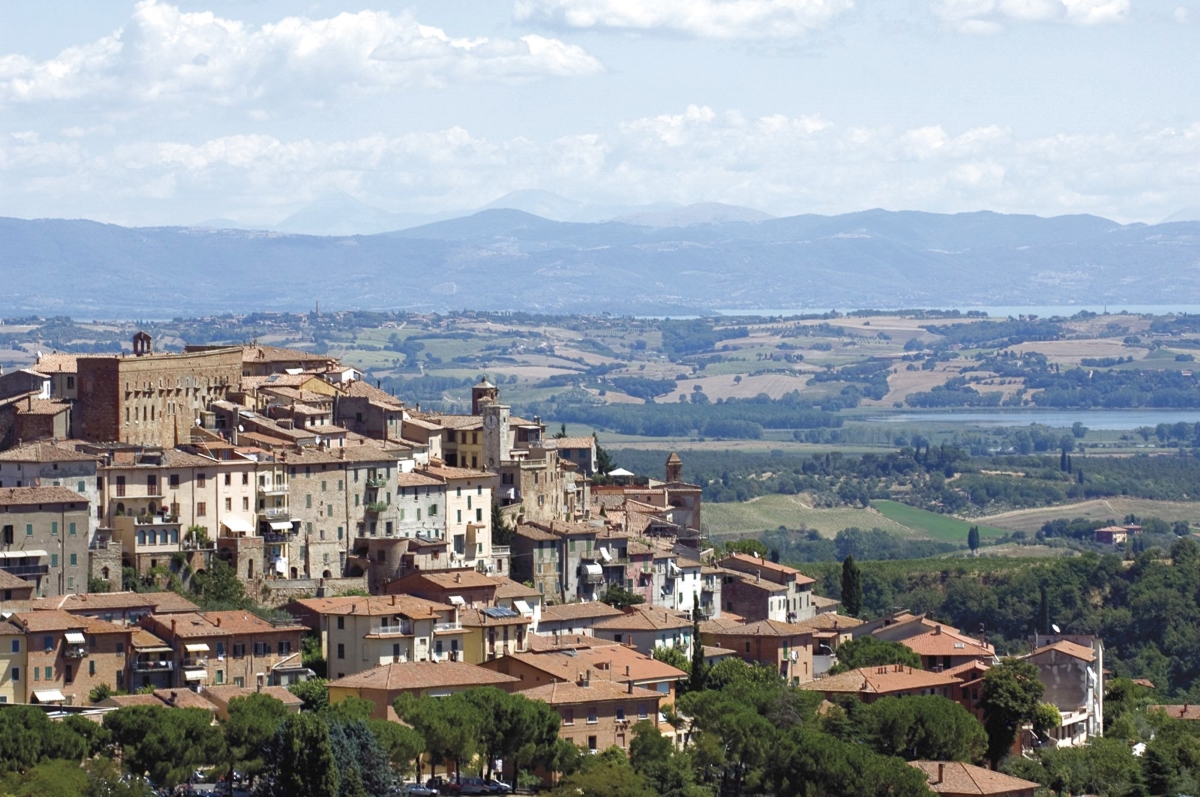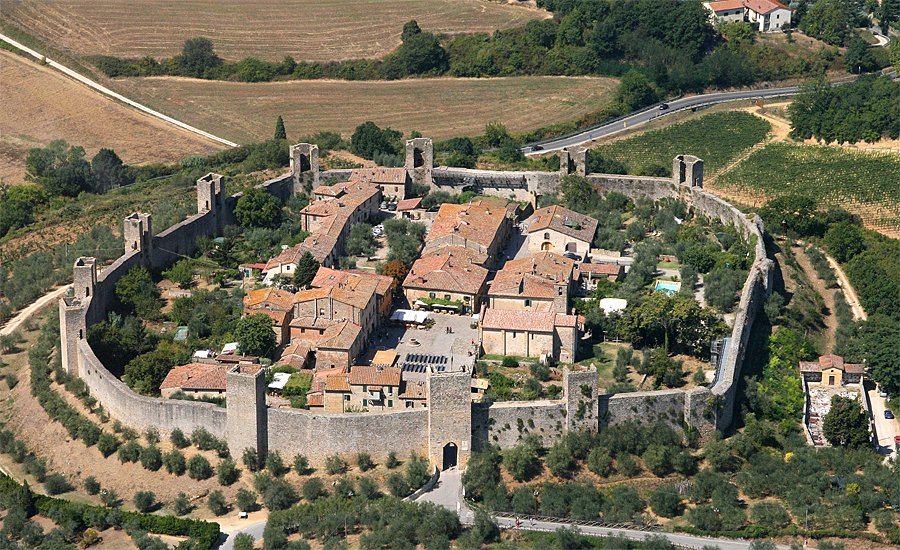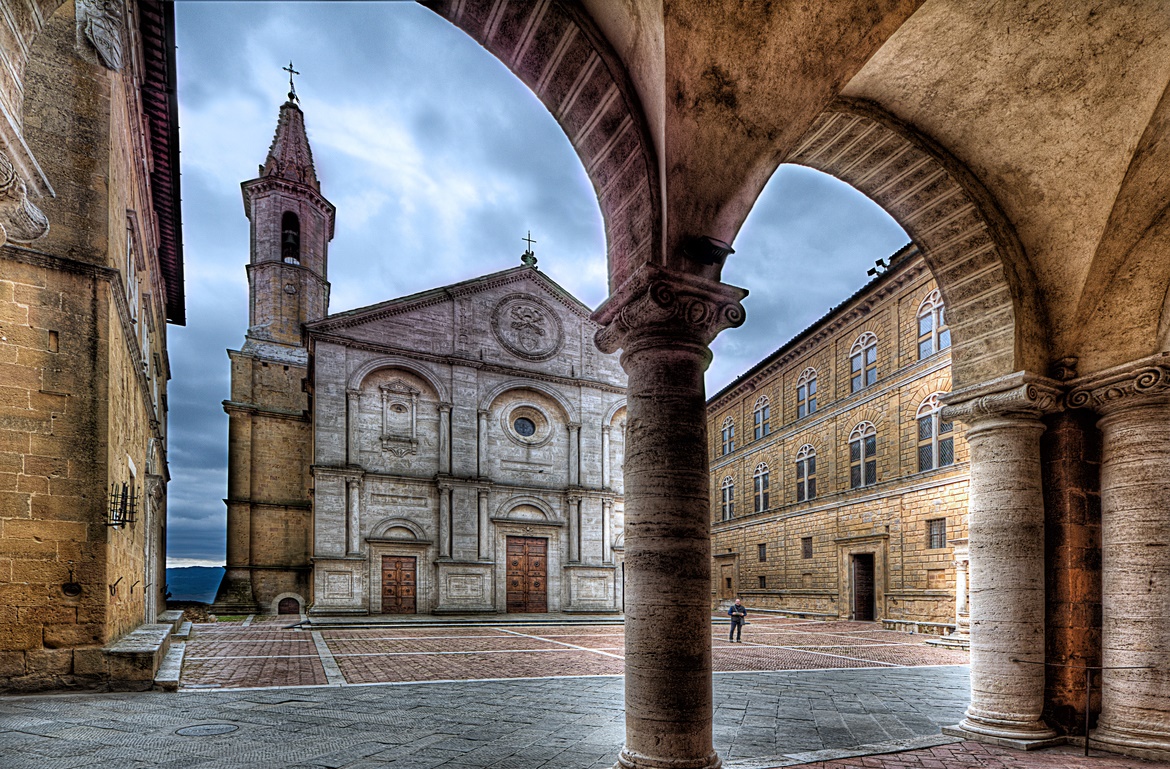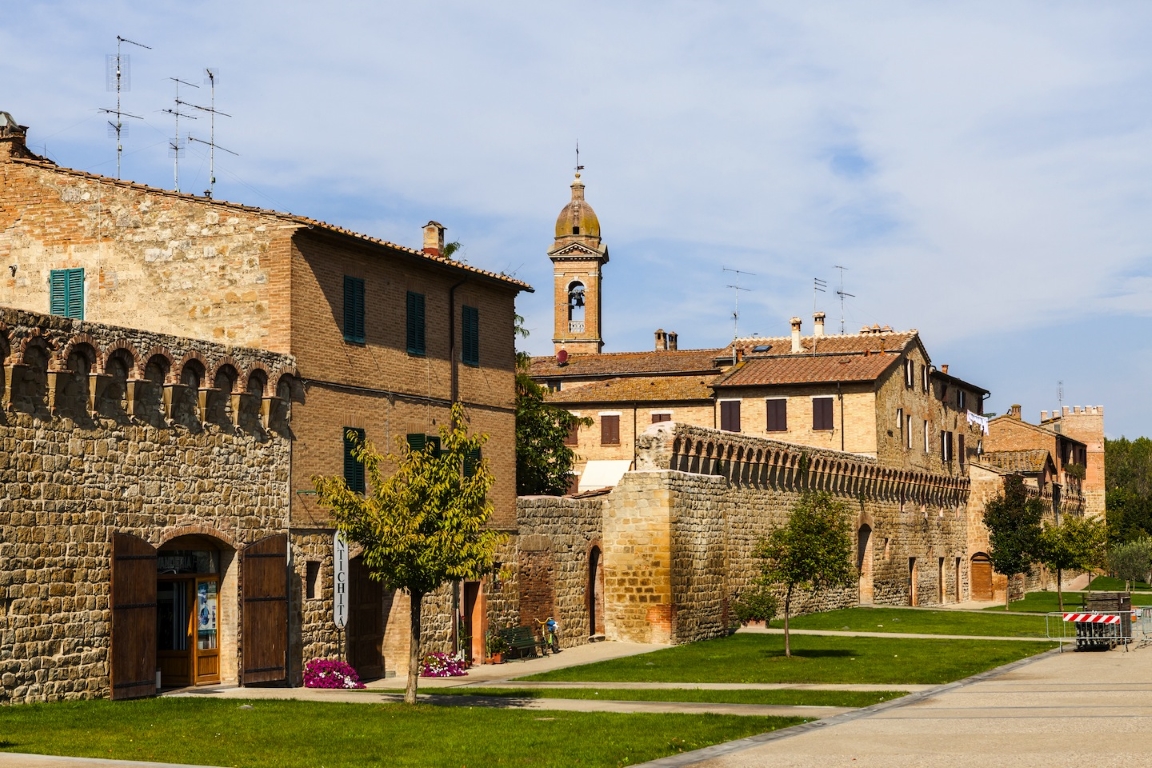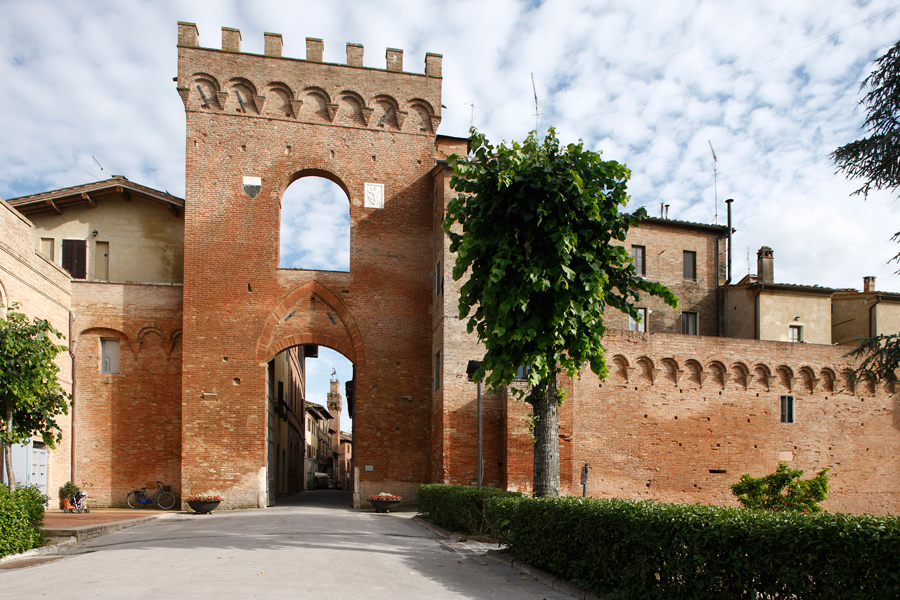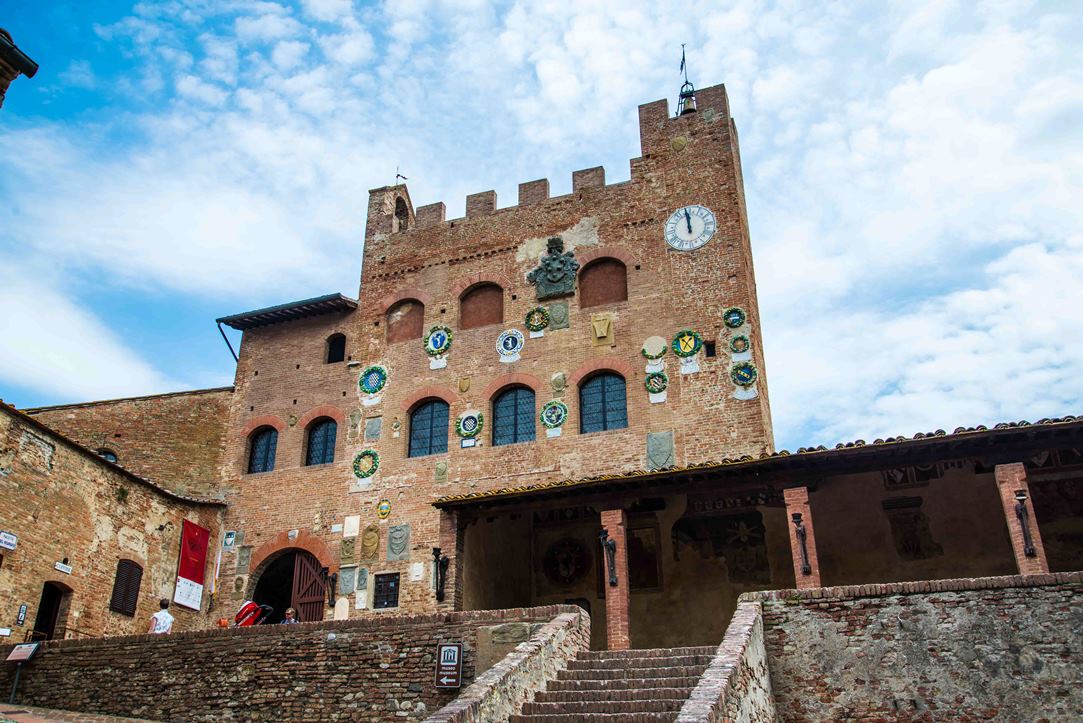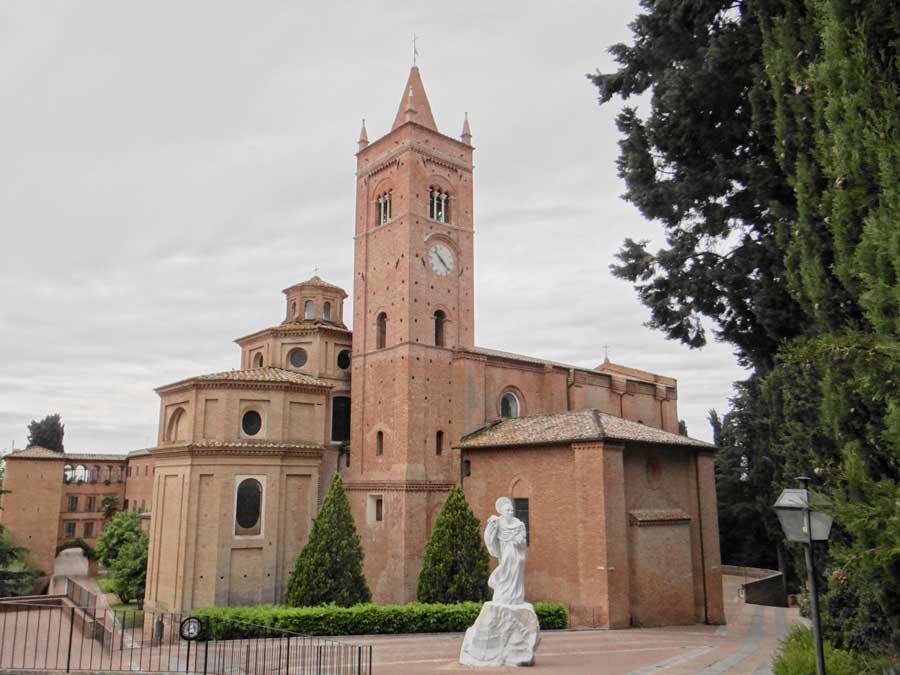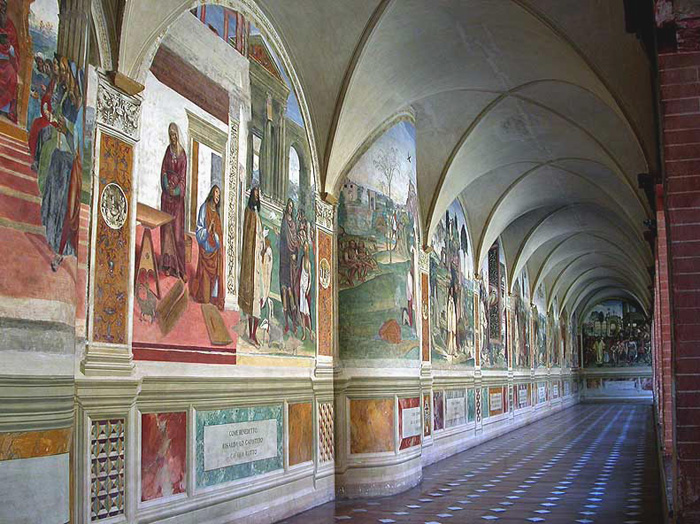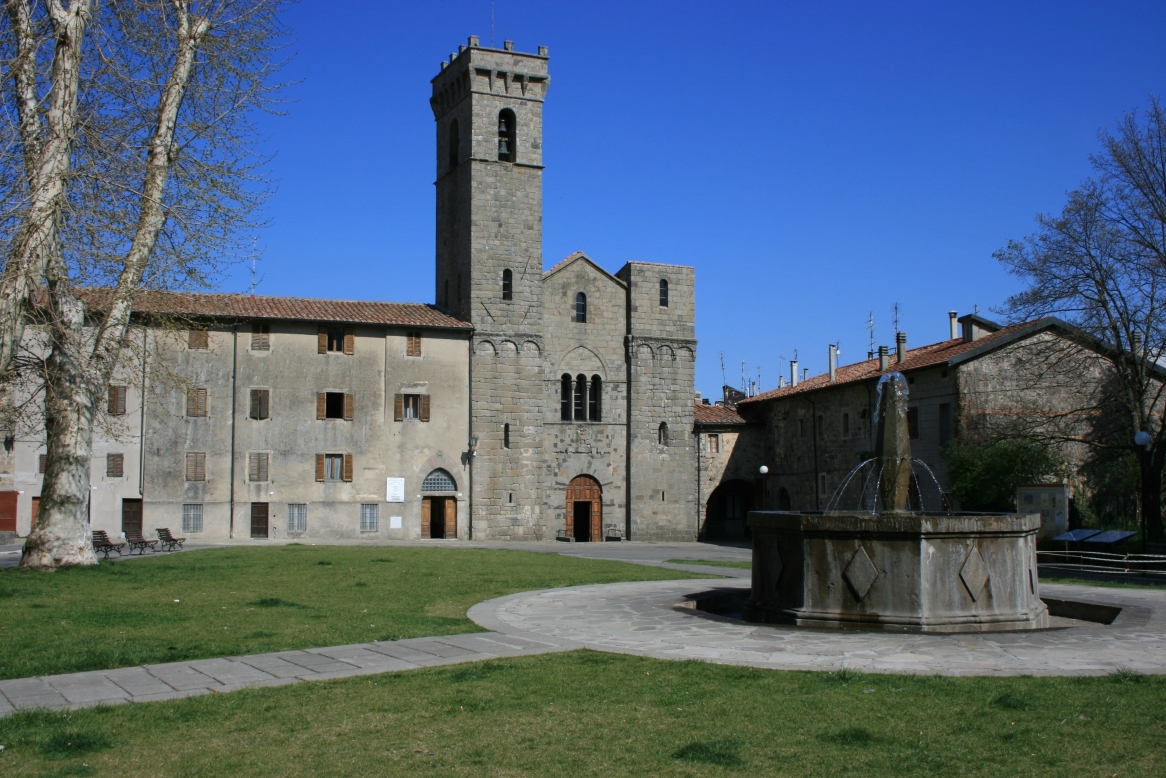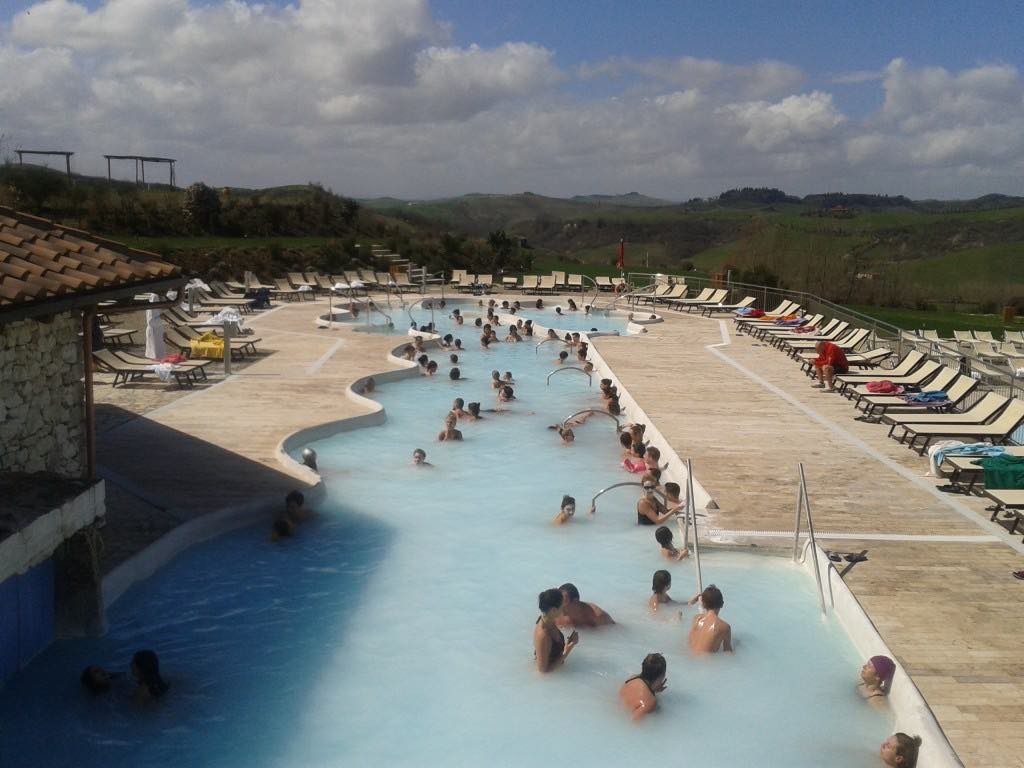Siena and Surroundings
SIENA
Siena is found in the X century in the center of important trade routes that led to Rome and, as a result, it became an important medieval city. In the 12th century the city was given consular orders, began to expand its territory and tighten the first alliances. This state of political and economic relevance, lead to Siena a fight for the northern provinces of Tuscany against Florence. From the first half of the twelfth century onwards Siena thrives and becomes an important shopping center.
PALIO DI SIENA
The Palio is a complex event organized by the Municipality of Siena.
There is no reliable date for Palio’s origins, as there is no precise news for the foundation of the city that in the myth begins with a long “run” by the children of Remo, Senio and Aschio, who have reached the City after The escape from Rome.
Certainly the Palio is ancient as Siena, and its history is always interwoven with that of the city. In the Golden Age of the Republic of Siena – 150 years between the beginning of the XIII and the XIV century – Palio was the solemn and conclusive moment to celebrate the Assumption in mid-August.
It was, of course, a post in a different form from the present; At the beginning of the 14th century, with the non-jockey knights and the winner, who came to the old cathedral, after departing from one of the gates of the city, they had received a long pallium, a drapery of precious Stoffa which then gave the name at the party.
The traditional Palio races take place in “Campo” on July 2 and August 16 each year; Except for the above mentioned events, extraordinary Palies can be made in exceptional circumstances or events.
IL MERCATO NEL CAMPO
An event that will take place on 6.12 and 7.12 will be Siena, included in the poster of ALL THE CHRISTMAS OF SIENA.
200 events until 31/01.
On December 6th and 7th, not only food and crafts but also art and music for the Market in the Field!
SAN GIMINIANO
San Gimignano stands on a place inhabited by the Etruscans, at least from the 3rd century BC. The hill was chosen for strategic issues, being dominant (324 m above sea level) on the upper Val d’Elsa. On the slopes of Poggio del Comune (624 m above sea level) there are the ruins of Castelvecchio, a village of the Lombardy era. The first mention goes back to 929. In the Middle Ages, the city was on one of the routes of the Francigena Street, which Sigerico, archbishop of Canterbury, traveled between 990 and 994 and for him represented the XIX stage (Mansio) of his route to return from Rome to England . Sigerico named Sce Gemiane, signaling the village as a point of intersection with the road between Pisa and Siena.
According to tradition, the name derives from the holy bishop of Modena, who would defend the village from the occupation of Attila. The first wall of the town dates back to 998 and included the hilltop of Montestaffoli, where there was already a fortress of the market owned by the bishop of Volterra, and the tower of the Tower with the bishop’s castle. In 1199, in the midst of its economic splendor, the country gained its municipal independence over the bishops of Volterra. The solid economy allowed the creation of an aristocratic urban class, which expressed its political and social supremacy in the construction of the towers: in the 14th century it came to count 72 towers (today there are perhaps 14). The large accumulated capital was invested in the course of the 13th century in important public works, which gave the town the articulation of urban spaces still visible today.
In 1251 the walls enclosed Montestaffoli, but a few years later, in 1255, the city was taken by the guelphs of Florence who ordered the destruction of the walls. Regained independence in 1261 and Ghibelline supremacy returned after the Battle of Montaperti, the Sangimignanes reconstructed the walls including the Tower’s hilltop. Since then, the town was divided into four districts, each corresponding to a main door: that of Piazza, Castello, San Matteo and San Giovanni.
MONTEPULCIANO
The inhabited center has features of medieval hamlet “S” and is enclosed within three wall circles, all built around the 14th century.
Of Etruscan origin and founded, according to legend by Porsenna, Lucumone of Chiusi; Some of the documents and finds found in the fortress are dating back to the IV-III century BC. In the Roman era it was the seat of an army defended in the consular streets. It was evangelized by San Donato, bishop of Arezzo in the fourth century.
The 14th century was marked by strong controversy over power among the major families; A relative stability took place under the Sheep’s Family, which, divided into Florence, Siena or Perugia, became Signori di Valiano and tyrants of Montepulciano.
In 1390 Montepulciano became firmly allied with Florence, which was urged to have a strategic position south of Siena.
From the beginning of the fifteenth century to the middle of the sixteenth century, Montepulciano had its golden age, marked by political stability, cultural prestige, artistic flourishing.
The long season of Lorence marked Montepulciano the beginning of a widespread economic and social recovery. The reclamation of Valdichiana favored the agricultural recolonization of the fertile valley bottom; The resulting reorganization of the road system facilitated business contacts.
MONTALCINO
The hill on which Montalcino is located has probably been inhabited already in Etruscan times.
Montalcino is mentioned for the first time in a document dated December 29, 814, when Emperor Ludovico il Pius granted the sub-area Lucini to the Abbot of the nearby Abbey of Sant’Antimo.
The first living nucleus is believed to date back to the 10th century. During this time the population had a considerable population growth when the inhabitants of Roselle moved to the city. The original living nucleus would extend over the centuries until reaching the current dimensions in the 14th century.
During the late Middle Ages it was still a common independent of great importance due to its position on the old Via Francigena, the main road between France and Rome, but over time Montalcino entered the orbit of the mighty Siena.
After the fall of Siena 1555, the Sienese nobles roamed the city for 4 years with the hope of returning to Siena one day, giving life to the republic of Siena, sheltered in Montalcino. But in the end Montalcino also joined the Grand Duchy of Tuscany up to Unification of Italy 1861.
VOLTERRA
The hill on which Volterra rises was already inhabited during the first age of the iron, as confirmed by the great villanovian necropolis of the Ripaie and Guerruccia, located on the slopes facing west and north. The settlements along the hills found their meeting point in the area of the necropolis where, around the end of the eighth century BC, it began to hold markets and to create areas of worship, giving rise to the process of sinecism that originated the first nucleus urban.
Archaeological finds referring to the 7th and 6th centuries BC Are poor, but show a persistence of Villanovian culture alongside the earliest evidence of orientalizing culture.
The walls, still largely visible today, were built at the end of the 4th century BC. And they had an extension of 7300 meters. In addition to the enhanced urban center, they also protected the sources, the fields and the pastures necessary to survive the flocks of the surrounding villagers who fled inside to save themselves from the lootings that the Gauls and the Ligurians often carried out in these areas.
From the 4th century BC The archaeological finds are rising and the history of the city reached its highest splendor when the southern Etruscan cities (Veio, Tarquinia, Cerveteri, Vetulonia, etc.) began to decay because of their proximity to the rising power of Rome. The city maintained good relations with Rome and during the Second Punic War provided Scipione grain and ships. Loyalty was rewarded and in 90 AD The volcanoes gained Roman citizenship.
In the years of the crisis and decadence of the Roman Empire, Volterra did not leave any news of himself.
ABBAZIA DI SANT’ANTIMO
The original nucleus of the Abbey of Sant’Antimo dates back to the cult of the relics of Sant’Antimo of Arezzo, to whose death in 352 a small oratory was built at the place of his martyrdom. At the same place a Roman villa was erected. It is proved by the numerous Roman finds such as the bas-relief with the cornucopia on the north side of the bell tower or some columns in the carolingian crypt. The “Venite et bibite” engraving would instead suggest a source of therapeutic properties. In 715 the church was guarded by a priest of Chiusi diocese.
In 770 the Lombards commissioned the abbot Pistoia Tao to begin building a Benedictine monastery and also entrusted him with the management of the country’s state property. The abbeys were used as a stop by pilgrims directed to Rome, merchants, soldiers and kings.
On December 29, 814, a document by Ludovico Pio, son and successor to Charles, enriches the abbey of gifts and privileges. The abbey is in all respects an imperial abbey.
CHIANCIANO TERME
The beneficial properties of the mineral waters of this town were already appreciated by the Etruscans and Romans, who had occupied the area permanently by building an important inhabited center. The presence in this area of numerous burials makes for a settlement, perhaps more than one, gravitating around the city of Chiusi. However, if Chiusi reached the period of greater splendor in the 5th century BC, Chianciano is rich in the remains of the Bronze and Iron Periods. Among these is the eneolithic settlement of Chiarentana, on the slopes of Mount Cetona, where the foundations of some huts were discovered with the presence of ceramic and material remains in obsidian.
The discovery of these objects testifies to a rich commercial exchange that existed with the Pontine archipelago, and in particular with Palmarola Island, an oxide production site. At the end of the Iron Age (X – IX century BC) in these hills overlooking the Val d’Orcia formed a rich and populous settlement of which there is no trace but that surely existed because of the rich necropolis in Excavation course since 1990.
ABBAZIA DI SAN GALGANO
At the will of the bishop of Volterra Ugo Saladini at the place of the death of San Galgano a chapel was built around 1185. The bishop succeeded him, Ildebrando Pannocchieschi, but promoted the construction of a real monastery.
In 1218 the construction of the abbey began in the underlying Merse plain. The designer seems to have been donnus Johannes who had completed the work in the Casamari abbey last year.
The work proceeded quickly, so that in 1227 a higher church (Montesiepi) and a lower church were witnessed. In 1228 one of the infirmaries was completed and the following year they completed the construction of the abbey cell.
In 1262 the work was almost completed and in 1288 it was consecrated. The great abundance of the abbey led its monks to take on a significant economic and cultural importance so as to push the Republic of Siena to close ties with the community.
In the 14th century, the situation began to deteriorate: first, the famine of 1328 and the plague of 1348, which saw the monks severely affected by the disease, led to the halt of the development of the Cenobio. In the second half of the century, the abbey, like all the Sienese countryside, was repeatedly plundered by venture companies, including two times by those of John Acuto, who roamed the territory.
In 1503 the abbey was entrusted to an abbot commendatario, a choice that accelerated the decadence and ruin of the whole complex. The government of the commendatary abbots turned out to be wicked, so that one of them, in the middle of the century, removed to sell the lead cover of the roof of the church:
In the first half of the eighteenth century the complex was now collapsed into several parts and those still standing were still for a while. In fact, in 1781 it collapsed as it was sometimes and in 1786, after a lightning hit him, the bell tower collapsed; He saved the greatest bell from the 14th century, but for a few years, in fact, a few years later he was merged and sold as bronze. In the following years the abbey was transformed into a foundry, until in 1789 the church was definitively defunct and abandoned. Monastery premises instead became the home of a farm and were partially restored already in the early decades of the nineteenth century.
Towards the end of the nineteenth century the interest in the monument was restored. The restoration began, there was an emphasis on architectural structures and the whole building was at the center of a vast historical study, accompanied by a photographic campaign performed by the Fratelli Alinari in Florence.
In 1924 the restoration was carried out with a conservative method by Gino Chierici, who was inspired by the principles of John Ruskin, the father of conservative restoration. There were no arbitrary reconstructions or integrations, therefore, it simply decided to consolidate what remained of the monastery.
LA SPADA NELLA ROCCIA
Of St. Galgano, who is the owner of the place that is celebrated on December 3, is known to have died in 1181 and who converted after a disorderly youth retired to hermitic life to indulge in penance, with the same intensity as he had first given to debauchery.
The culminating moment of conversion took place on Christmas Day of 1180 when Galgano, on the Montesiepi hill, entered his sword into the ground to transform the weapon into a cross; In fact in the Roundabout there is a boulder whose slits emerge from an elk and a segment of a corroded sword from the years and rust, now protected by a plexiglass teak. The obvious echo of Arturian myth has not failed to raise curiosity and, of course, some bold hypothesis about possible relationships between the mythology of the Round Table and the story of the holy Chiusdinese.
In many biographies of San Galgano, including the Vita Sancti Galgani de Senis, he refers to the contacts that the saint would have with the hermitage of San Guglielmo di Malavalle (Castiglione della Pescaia in the province of Grosseto). There are many affinities between the two characters: both riders, both decided to vote for the hermitic life by abandoning the earthly militia, both of which have links to Arturian matter. San Galgano pours his sword into the rock, with a similar gesture, but inversely to that of Arthur who takes it out. Guglielmo, according to an ancient folk tradition in certain localities in the area (Castiglione della Pescaia, Tirli, Buriano, Vetulonia) would in fact be William of Aquitaine, Eleonora’s father, whose court was Chrétien de Troyes, author of Le Roman de Perceval ou Count Grail, in which the Holy Grail appears for the first time. William X Aquitaine died in 1137 as he was on a pilgrimage to Santiago de Compostela but no one ever saw his body. He left eldest daughter of Eleonora his vast domain. It may be the saint of Malavalle that appears in Maremma some years after these facts. For the first time, it is mentioned in Vita S. Guilelmi written after 1210. The results of scientific investigations carried out on the relics of Saint William, including that of mitochondrial DNA, make the character’s Nordic origin very likely.
MONTERIGGIONI
The Castle of Monteriggioni was built by the Sienese, by order of the Podestà Guelfo da Porcari, in a period between 1214 and 1219. The land, bought by the noble family From Staggia, was the seat of an ancient Longobarda farm
The construction of the castle by the Republic of Siena was primarily defensive, as the village rises on Mount Ala in domination and surveillance of the Francigena, to control the valleys of Elsa and Staggia in the direction of Florence, a historic rival of Siena.
The circular pattern of the walls was obtained simply by following the natural course of the hill.
There is no agreement among historians about the presence of the drawbridge. Certainly, there were the presence of the shutters, or thick wooden doors covered with iron that were operated by pulleys. Even today the two doors have the signs of the hinges and holes caused by the closure rods. On the door of San Giovanni you can also see the signs of the rivellino, another defensive structure of rectangular shape placed in front of the door and also equipped with a drawbridge or a second door.
The Castle of Monteriggioni was also surrounded by so-called carbonaie, or ditches full of charcoal that was burned to repel assaults.
COLLE VAL DELSA
It is perched on its oldest part on a high hill. In ancient times, the urban fabric was divided into three parts: the Borgo di Santa Caterina, the Piticciano Castle and the Plan, now simplified in “Colle alto” and “Colle basso”. The municipality is the most important Italian center of crystal production.
Starting from numerous important archaeological finds dating back to the 4th millennium BC, the first documents that bear witness to Colle di Val d’Elsa dates back to the 10th century, but only later, between the XI and XII century, the city acquires Their own identity. There are numerous testimonies of the area dating back to Etruscan times, such as the necropolis of Dometaia and de Ville.
The history and the identity of Colle di Val d’Elsa are born and developed, together with the other Valdelsa (San Gimignano, Poggibonsi and Casole d’Elsa) villages, in the shadow of ecclesiastical and civil lords . It should not be forgotten that in the High Valdelsa they passed the Via Francigena and its variants by bringing a considerable amount of goods and men’s trades and thus guaranteeing a safe income.
PIENZA
The city until 1462 was just a small hamlet named Corsignano. The event that changed its destiny was the birth in 1405 by Enea Silvio Piccolomini who 53 years later became Pope Pius II. Just a journey of the pontiff towards Mantua led him to cross the birthplace and the degradation he found led him to decide on the construction of a new ideal city over the ancient village.
For the beauty of its old Renaissance center in 1996, Pienza became part of the Natural, Artistic and Cultural Heritage of UNESCO, followed in 2004 by the same valley where it rises: the Val d’Orcia.
In 2003, in the Lucciola Bella nature reserve, the fossil remains of an Etruridelphis giulii (a dolphin-like marine mammal) lived in the area more than 4.5 million years ago, at a time when current calamities were the backdrop Of the Tyrrhenian Sea. Fossil has been considered by scholars of great scientific value, because it is the most complete repository of the species present in the world
BUONCONVENTO
The name comes from the Latin “Bonus Conventus” happy, lucky place.
The early history dates back to around 1100 but certainly the most important thing happened in 1313 when, on August 24, perhaps not in the capital, but still within the municipal territory, the Emperor Henry VII of Luxembourg died Better known as Arrigo) who had come down to Italy to restore the imperial authority. History tells that the Emperor, poisoned during communion by a local friar, died shortly along Cassia Street, probably in the village of Serravalle.
The construction of the walls began in 1371 and ended 12 years later, in 1383. It is the most important center of the Val d’Arbia, also witnessed by the Podesteria which includes 32 sites and the recognition of the Sienese citizenship granted by the governors of the city in 1480.
With the fall of the Republic of Siena, in 1559 it became part of the Grand Duchy of Tuscany under the doctors.
SAN QUIRICO D’ORCIA
In the Middle Ages the town was located on the route of the Francigena Street. Sigerico, Archbishop of Canterbury, in his itinerary, completed between 990 and 994, quotes San Quirico as the XII submersio and defines Sce Quiric. To increase its importance, it also contributed to the gathering point of the Umbrian-marchigian merchants heading to Florence and Siena from the famous Guido Morgante, who came through the Valley of Chienti, Colfiorito, Foligno and Perugia to San Quirico.
San Quirico also has some important historical and artistic churches: in addition to the already mentioned Collegiate Church of San Quirico (more precisely Collegiate of the Saints Quirico and Giulitta) and the Romanesque Church of San Biagio in Vignoni, the Church of San Giovanni Baptist in Bagno Vignoni, the Church and Chapel of Our Lady of Vitaleta, the Church of Santa Maria Assunta and the Oratory of Mercy.
BAGNO VIGNONI
The village is located in the heart of Tuscany, inside the Natural Artistic Park of the Val d’Orcia and thanks to the proximity to the Via Francigena (the main route followed in ancient times by the pilgrims traveling to Rome), the waters flowing in this Place had been used since Roman times for thermal purposes.
At the center of the village is the “Piazza delle sorgenti”, a rectangular bath of sixteenth century, which contains a source of hot and steamy thermal water coming out of the underground foothills of volcanic origins. From the time of Etruscans and Romanians – as evidenced by the numerous archaeological finds – the baths of Bagno Vignoni were attended by illustrious characters, such as Pope Pius II, Catherine of Siena, Lorenzo de ‘Medici and many artists who had elected Borgo as a holiday resort.
Characteristic of Bagno Vignoni, in addition to the thermal waters, is its structure that, despite the numerous episodes of war, devastation and fires that involved the Val d’Orcia during the Middle Ages, has since remained largely unchanged over time. From Bagno Vignoni you can easily reach and visit the nearby centers of Pienza and Montalcino and in general the whole Val d’Orcia and Monte Amiata Park.
The waters emerging from the spa begin to the steep slope of the Natural Park of the Mulins. Here, immersed in the Mediterranean scrub, there are four medieval mills excavated in the rock that were very important to the local economy as the perennial thermal spring guaranteed their operation even in the summer, when the other mills in the area were stopped due to the rivers Dry.
MURLO
Murlo is a land of Etruscan people, testimonies of the Etruscan origins of the municipality can be admired at the local “Antiquarium Museum of Poggio Civitate” located in the historic center. Genetic analyzes carried out on the Murlo population showed an unusually high presence of typical characteristics of Middle Eastern populations, according to the theory of the Anatolian origin of the Etruscans.
ABBADIA ISOLA
The abbey was founded in 1001 by countess Ava, daughter of Count Zanobi and widow of Ildebrando Lord of Staggia and Val de Strove, along the Francigena Street and in particular at one of the castles owned by the same family called Borgonuovo.
It has its name in the environmental context, as, rising on the edge of impaled land, the church seemed to rest on an island.
The castle of Borgonuovo was also mentioned by Sigerico of Canterbury, which made it between 990 and 994, returning from Rome after receiving the investment from Pope John XV with pallium delivery. Walking along the Via Francigena, Archbishop of Canterbury mentions in his diary Burgenova. The resort was the 16th stage (bunks) of its route to England.
The abbots became the absolute bosses of Borgonuovo and the surrounding lands in the following centuries, so that castle lost progressively importance in favor of the abbey, whose power culminated in the 14th century. There is proof of a convention signed at Badia in Isola on 11 December 1256 between the abbot and the rector or mayor of the municipality of Borgonuovo, with which it is granted to the inhabitants to be able to elect a person of their trust by rector.
ASCIANO
In addition to rare finds due to the Romanesque era at the Bronze Age and at the Iron Age, Etruscans are the contexts that most commonly characterize the entire communal territory.
The theater of the main Etruscan finds in the communal territory of Asciano is the Tumulus of the Molinello (used from the 7th to the 1st century BC) and the necropolis of Poggio Pinci (V.C.C.)
While the Etruscan contexts found are exclusively funerary and sacred, the only monumental evidence of Roman era is pertinent to a residential structure and consists of a mosaic preserved in Via del Canto.
Asciano’s news in the Longobard times are linked to a church, controversial in 714, among the bishops of Siena and Arezzo, identified with the now defunct Church of St. Ippolito. Later the center became the feudal of the Counts of Cacciaconti-Scialenga (IX century), until it was purchased by the Commune of Siena in 1275. In the 14th century, the Sienese strengthened the walls until the fall of the Republic in 1554. Since then, Events of the Grand Duchy of Tuscany.
CERTALDO
Certaldo had Etruscan-Roman origins, as evidenced by the numerous archaeological finds scattered throughout the communal territory, such as ceramics, tools and Etruscan tombs, some of which have recently been discovered. The Etruscan origins are also evidenced by the toponymy of some localities and streams, such as the Agliena torrent and the Elsa river that flow near Certaldo.
In particular, on the Poggio del Boccaccio, a trapezoidal shape with an elliptical base and a completely flat top, adjacent to the medieval village in the northwest, were discovered during archaeological digging in the late 1800s and mid 1900s An Etruscan-Hellenistic tomb of an elliptical plant dating to the end of the IVth-3rd century BC, and a well-stocked grocery store with some hard-wearing instruments dating back to the Hellenistic era. Most likely the area was home to a fine grain store from 300 BC
In other excavations, carried out between the 19th and the 20th centuries near another artificial hill, always adjacent to the medieval village, but this time south-east, called Poggio delle Fate, a cellar barn and cellars were found Remains of an Etruscan mound and numerous tile slabs, while numerous ceramics dating from the 6th to the 5th century BC Until the Hellenistic age and fragments of pottery ceramics were found near the Agliena stream.
Some finds of Roman amphorae dating back to the imperial era (1st century AD) at the Liberty Square, in the lower part of the city, during some 1960s construction works for the construction of a middle school, show that there were settlements even in Roman times .
All these finds of Etruscan and Roman origin are now museumed on the ground floor of Palazzo Pretorio, located in the medieval part of the village.
In all likelihood, in the place where Certaldo now stands, there was a small Etruscan settlement, probably in an agricultural village, as evidenced by the deposits of crops in the hills adjacent to the village, while on the Poggio del Boccaccio there was a necropolis.
ABBAZIA DI MONTE OLIVETO MAGGIORE
The origins of the abbey of Monte Oliveto Maggiore – 1313
Followers of the Benedictine Order, the Olivetans founded their monastery in 1313. Blessed Bernardo Tolomei (1272-1348) constituted a religious community with the name of the Congregation of Santa Maria di Monte Oliveto, on the homonymous hill halfway between Siena And Arezzo. In 1319 the foundation was approved by the bishop of Arezzo Guido Tarlati and was included in the Benedictine rule; The following year the monastery began, and in 1344 the Olivetan Congregation received confirmation from Pope Clement VI (1342-1352).
ABBAZIA DI SAN SALVATORE
The Abbey of San Salvatore is the sacred building which gives its name to Abbadia San Salvatore.
Tradition wants the Benedictine complex, attested by 762, to be founded by Duke Longobardo Ratchis. The abbey had the most splendid period from X to XII century; In 1782 it was suppressed and the church reduced to parish.
The church, dating back to 1035, has a high and narrow hut, side by side with two towers, the one unfinished right and the other merlato. The present aspect is partly the result of restorations of the 1930s. The interior, with a Latin cross, retains a polychrome wood crucifix at the end of the twelfth century, the Duke’s Legend of Ratchis (1652-1653) and the Martyrdom of St. Bartholomew (1694), both of Francesco Nasini.
The crypt is characterized by the presence of thirty-two columns with capitals, each decorated with a different motif, as are the columns.
The Abbey has hosted Codex Amiatinus for almost a thousand years.
ABBAZIA DI SPINETO
The structure then appeared as a typical feud, around which they turned agricultural, crafts and spiritual activities. With the fall of Siena this territory also under the rule of the powerful family of the Medici, and having lived its period of maximum splendor between the 12th and 14th centuries, was definitively abandoned by the religious order and began to pass in 1830 Private hands.
TERME DI RAPOLANO
Rapolano Terme is an Italian municipality of 5,248 inhabitants in the province of Siena in Tuscany. The municipality, formerly known as Rapolano, assumed its name only in 1949. It is a spa resort that has two factories: the San Giovanni Spa, immersed in the Sienese hill, and the ancient Querciolaia Baths, very close to the town center.
TERME ANTICA QUERCIOLAIA
The nucleus of the spa complex (the second half of the nineteenth century) shows an indissoluble bond with the source: the horseshoe shape was designed to embrace, almost protect, the source.
History includes an illustrious guest who benefited from the healing properties of the source: Garibaldi, the hero of the two worlds, at the spas of Tuscany, cared for the wounds of Aspromonte’s wound.

 Italiano
Italiano

